Is Intermittent Fasting Sustainable
Is Intermittent Fasting Sustainable
DEFINITION | HOW DOES IT WORK | FASTING FOR WEIGHT LOSS | WHAT TO EAT | WHAT TO DRINK | HOW TO TRACK | 21-DAY INTERMITTENT FASTING PLAN
TYPES OF INTERMITTENT FASTING: 16/8 | 18/6 | 5:2 | 20/4 | OMAD | 24H | CIRCADIAN RHYTHM | EXTENDED
Intermittent fasting – a two-word combination that was used only intermittently (see what I did there?) 10 years ago and now it seems like everybody is talking about it.
Even my 82-year-old grandma has told me she is "on" it.

But if you landed on this post, it means you are one of the thousands of people each day who want to finally learn and understand what the big fuss is about.
Perhaps, even try it yourself? Follow a step-by-step Intermittent Fasting guide and a daily plan?
Well, you came to the right place. We've been helping people to lose thousands of pounds and kilos through our Fasting challenges and intermittent fasting meal plans. Finally, we're putting all the most important information on Intermittent Fasting right here, in this guide.
And before I start with all the info, I just wanted to say thank you for coming here today. I hope after reading this, you will be fully ready to start the Intermittent Fasting journey yourself.
To make this 7023-word post a bit easier to navigate and consume, I've divided this text into 8 different chapters. Feel free to jump straight to the one you're really after.
So scroll down and let's get it started!
What is Intermittent Fasting
Intermittent fasting is an eating pattern where you cycle between periods of eating and periods of voluntary fasting over the course of a single day, week or other defined period.
Huh?
In human terms, it merely means controlling when do you eat and when you don't. The period when you don't consume any food or drinks (besides water) is called a fasting window. And the rest is called…eating window.
How long you choose to have your fasting or eating window is really up to you and your chosen Intermittent Fasting schedule. I will cover all the most common schedules and their pros and cons in a few sections below.
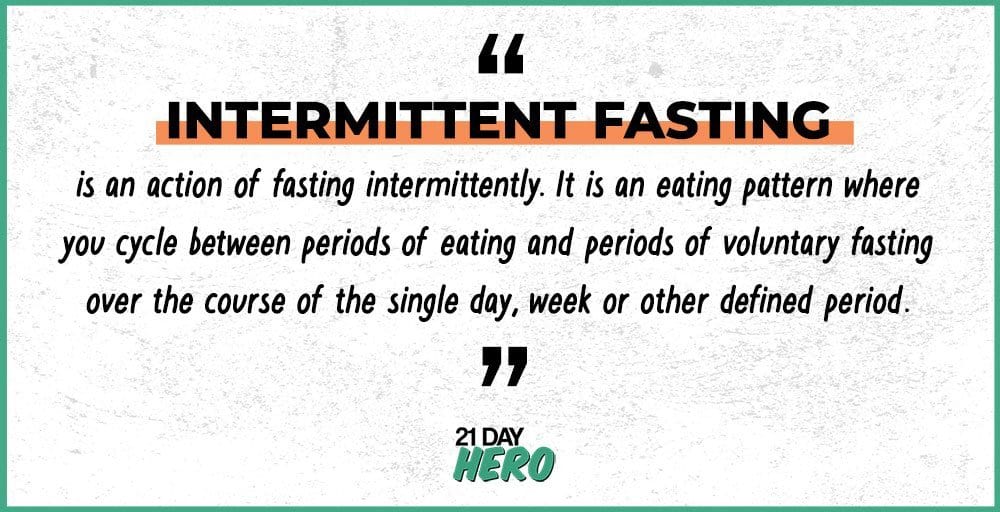
How Does Intermittent Fasting Work and Is It Safe
In the section above, we covered WHAT is intermittent fasting.
But we don't just want to blindly jump into doing something before understanding how does it work and is it the right fit with our goals, right?
"Right!" – I hear you saying.
How does intermittent fasting work
The power of Intermittent Fasting (IF) comes in two forms and shapes: caloric restriction (consuming fewer calories, than you need) and reduced meal frequency (how many meals/snacks you eat per day).
An average adult would have breakfast at 8 am, lunch at noon, snack at 3 pm, dinner at 7 pm and then an "I can't go to bed being hungry"-kind-of-snack at 11 pm.
That's five meals over the course of 15 hours and if you don't follow a strict portion control – you'll most likely consume more calories than you spent that day, which will result in gaining extra weight.
On top of that, your body will be working all that time digesting the food and will not have enough time left for so-needed recovery activities.
When following any intermittent fasting schedule you are reducing the meal frequency throughout your day, making it simply harder to eat 3 big meals and 2 snacks within twice or even less time (and please don't try to prove me wrong haha).
All of this results in a lower chance to go overboard with your calorie consumption and also more time for body to perform recovery operations such as autophagy.
Science of Intermittent Fasting for Weight Loss
To understand the science of intermittent fasting, we need to look into the basics of nutrition.
And it is quite straight-forward: the food we eat gets broken down to molecules and ends up in our blood, which feeds the cells in our bodies.
Part of those molecules are net carbohydrates (all carbs in the meal minus the fiber) and our body turns them into sugar (glucose) so our cells could use it for energy.
To be able to use sugar for the energy we need insulin, which is produced in our pancreas and spikes each time we throw in some food with carbohydrates.
Any excess sugars that we don't utilize get stored in the form of fat with the idea that we will use that fat for energy later, once we have no sugar left.
The best way to NOT end up having huge fat reserves (and becoming overweight) is to spend the same amount of energy you get from food.
However, life is not perfect and many of us have lifestyles that limit our chances to move throughout the day. In fact, office workers tend to spend 75% of their waking hours sitting.
So, what can we do to lose or not gain weight?
One way to do it is to focus on increasing your energy expenditure through increased physical activity or in layman's terms – exercising and doing sports. But you knew this one already, didn't you?
Another way though is to focus on consuming less food than you need for the energy that day and as a result, creating a caloric deficit.
And that's where intermittent fasting comes in.
Restricting the frequency of meals and creating long periods of fasting will end up reducing insulin to low enough levels and for long enough time so that our bodies get into the mode of ketosis – when you make a metabolic shift from burning sugar for energy to burning fat and ketones for energy.
Basically, your body starts to use a different type of fuel. Instead of relying on sugar (glucose) that comes from carbs, it relies on ketones, chemicals made in your liver that build up when your body starts burning stored fat for energy.
You can reach ketosis with the help of a keto diet or intermittent fasting. But to understand whether you have reached the magical fat-burning state called ketosis, you need to measure it.
There are multiple options on the market like blood or urine tests, however, by far, the most convenient and easiest test would be breath analysis. Breath ketone monitor like BIOSENSE will help you see all the stats on your true, fat metabolism rate during fasting hours.
Research suggests that a daily ketone score of 120 is associated with fat loss and with the help of ketone monitor you will be able to track your ketone levels throughout the fast or keto diet.
Breath ketone monitor allows for unlimited ketone testing and syncs with your phone to keep all the stats in one place. As you know "If You Can't Measure It, You Can't Improve It." Check out the BIOSENSE ketone analyzer, if you're interested in better understanding your fasting and weight loss trends.

Is Intermittent Fasting Safe and Healthy?
Yes, intermittent fasting does have a lot of benefits. We talk about them in our 21-Day Intermittent Fasting Challenge a lot.
In general, Intermittent Fasting is safe for most people, but you have to know the risks too.
It is also a good time to say that this article should and does not intend to replace advice from your doctor and you should always consult your physician before planning any fasting and especially extended fasting (longer than 24h).
Now that we made it clear, here are some of the cases (but might not be limited to) that does not go well with intermittent fasting:
- if you have a diabetes
- if you take medications for blood pressure or heart disease
- if you are pregnant or breastfeeding
- if you have a history of disordered eating
- if you don't sleep well
- if you are under 18 years old
Also, you should be a lot more careful if you are practicing extended fasting, which depending on the source you follow will be continuous fasting for either anything more than 24, 48 or 72 hours. There is a general consensus that any fasts longer than 72 hours should be done under strict medical supervision.
How to Start & How to Do Intermittent Fasting
One of the reasons I personally think Intermittent Fasting really took over is because of how easy it is to start it.
Literally, the only thing you should really decide before you start is which Intermittent Fasting schedule type you are planning to follow.
And before you make this decision, it is important to understand the various types of Intermittent Fasting.That's how you will find the one that works the best for you and fits your unique lifestyle.
For your convenience, here are the most popular Intermittent Fasting Schedules.
Types of Intermittent Fasting
Intermittent Fasting 16/8
How: Fast for 16 h and Eat 8 h
By following this 16/8 Intermittent Fasting Schedule, you fast for 16 hours and restrict your eating to an 8-hour eating window.
It is really up to you which 16 out of 24 hours you will decide to restrict yourself from eating. You can choose to have an eating window 8 am to 4 pm, 10 am to 6 pm, noon to 8 pm or any other schedule, as long as it is 16h of continuous non-eating.
The majority of the people who follow this schedule, choose to skip breakfast rather than dinner, but different people have different life rhythms.
What's great, that out of 16h, you'll probably be sleeping at least 7-8 of them, so we're really just talking about 9-8h of fasting each day.
It's also worth noting that we believe Intermittent Fasting 16/8 method is the most sustainable and easiest to start with, hence we suggest it for our 21-day Intermittent Fasting Challenge.
Finally, if you're looking for the meal plans to go along the 16/8 Intermittent Fasting schedule, you can get them here.
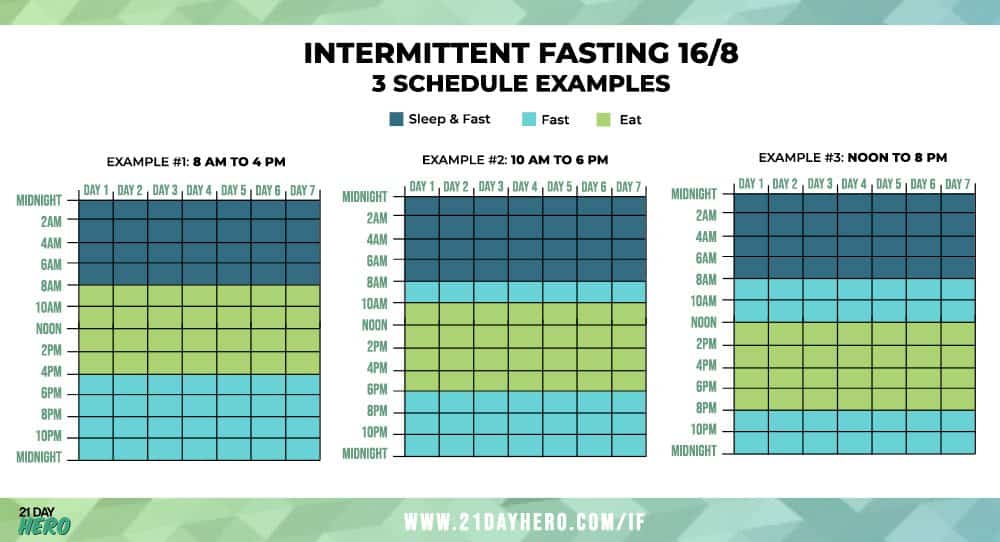
Intermittent Fasting 18/6
How: Fast for 18 h and Eat 6 h
Almost identical to the one above, if you choose18 /6 Intermittent Fasting Schedule, you should fast for 18 hours and restrict your eating to a 6-hour eating window.
It's just two more hours of fasting daily, but for a beginner faster, these 2 hours can make all the difference.
That's why we recommend starting with 16/8 for at least a month until moving to 18/6, because you'll have a much more enjoyable start and that's a crucial element between quitting and not.
Slow and steady wins the race – take it easy and listen to your body before going extreme.

Intermittent Fasting 5:2 a.k.a The Fast Diet
How: 2 days per week restrict calories to 500-600, 5 days per week eat normally
5:2 Intermittent Fasting lets you eat normally 5 days per week and restricts your calorie intake to 500-600 per day during the other 2 days. When choosing your fasting days, keep in mind that there should be at least one regular eating day in between.
Please note, that your results really depends on what you eat during the 5 days of non-fasting, thus stick to the nutritious and whole diet throughout for max results.
For more on the 5:2 diet, check out A Full Guide On 5:2 Intermittent Fasting.
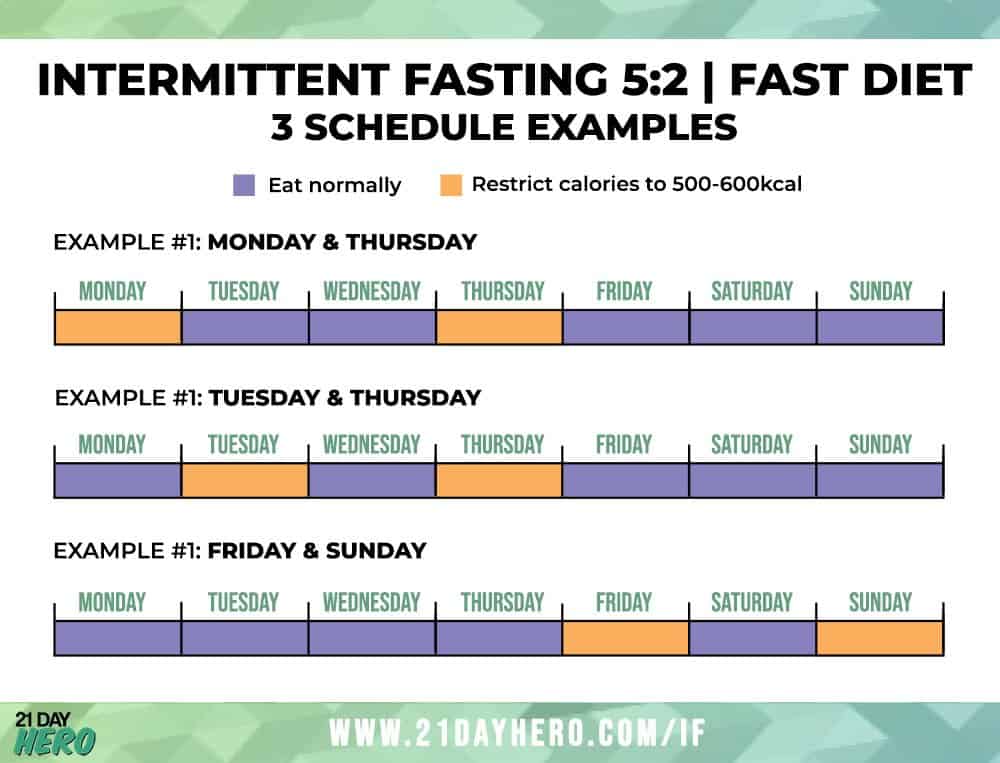
Intermittent Fasting 20/4 a.k.a. Warrior Diet
How: Fast for 20 h and Eat for 4h
In contrast to other methods, while following the 20/4 Intermittent Fasting Schedule, you are allowed to eat some raw fruits and vegetables, and some lean protein during the 20 hr fast period.
This fasting schedule is based on the idea that our ancestors spent their days hunting and gathering and would then feast at night. Therefore the 4-hour eating window shall be in the evening and you should follow a special order of eating specific food groups: starting with vegetables, proteins and fat, and eating carbs only if you are still hungry.
To read more about this type of fasting take a look at The Warrior Diet: All About Intermittent Fasting 20/4.
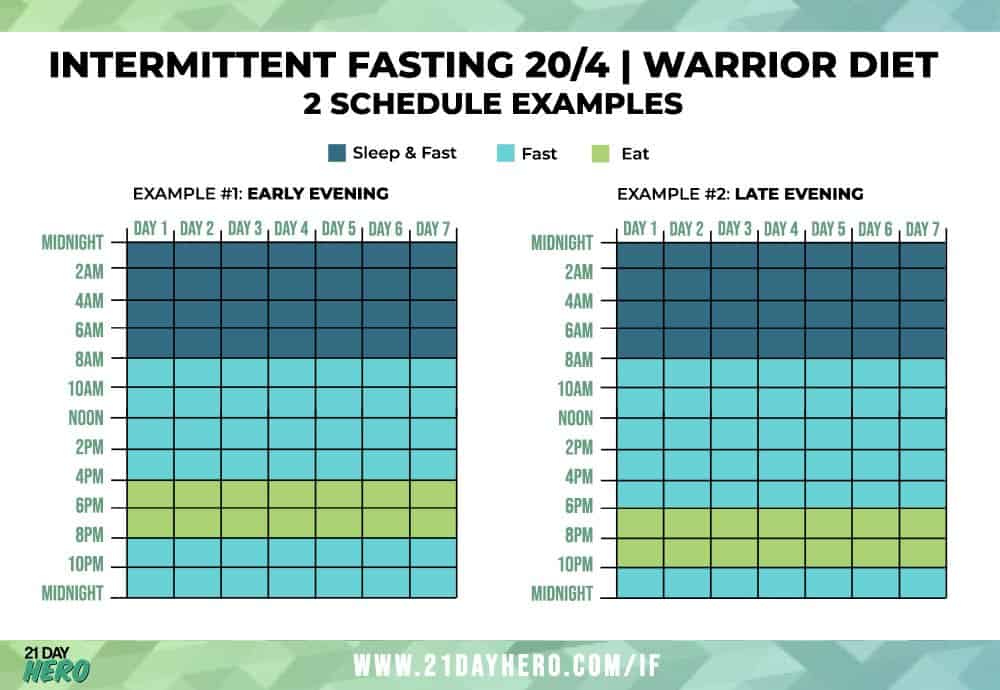
OMAD Fasting – One Meal A Day a.k.a. 23/1
How: Fast for 23h and eat once a day
Another popular fasting schedule is called one-meal-a-day (OMAD).
It is exactly what it sounds like – you choose a time in a day that is the most suitable for you to have your on and only meal of the day.
I know what you're thinking – isn't that almost starving? And yes, you are right – OMAD diet shouldn't be done without thought on how to get at least 1200 calories during that one meal.
Thus if you choose this 23/1 fasting – make sure your meal is a hearty and nutritious one.
If you're keen to try out OMAD – we do have a 21-Day OMAD Challenge that is packed with all the info you need, and also includes meal ideas and recipes to make it super simple.
A full article on OMAD diet you can find here: All You Need To Know About OMAD Diet
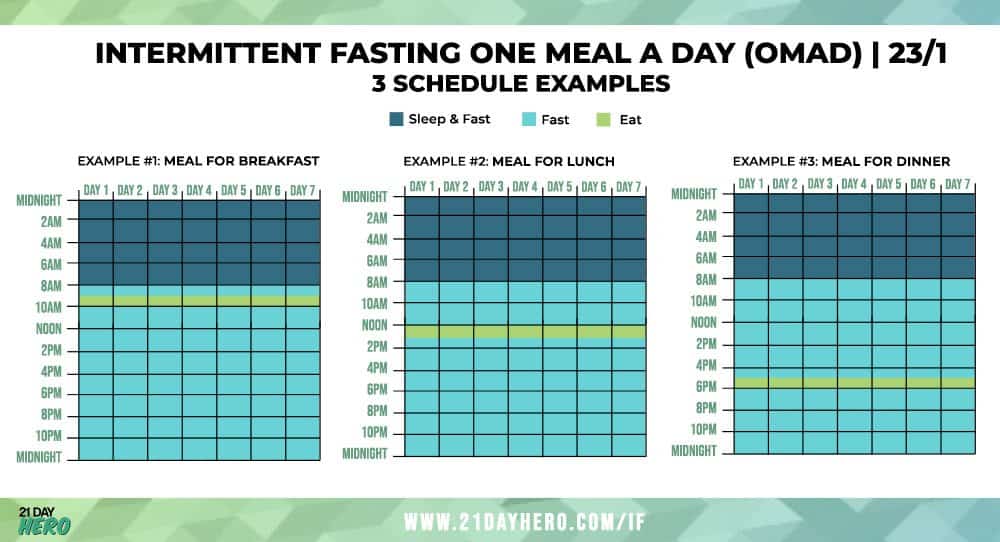
24hr Fast a.k.a. Eat Stop Eat
How: Fast for 24 h 1-2 times a week
While following 24 hours fast (popularized by Eat Stop Eat method, you should fast for 24 hours 1-2 days a week and eat normally on other days. That way, you should reduce overall calorie intake by ca 10% and hence lose weight.

Circadian Rhythm Fasting
How: Start fasting when the sun goes down and start eating when the sun goes up
You might have heard that our bodies have been designed to follow Circadian rhythm – an internal clock that runs 24h each day and regulates our energy levels based on the rhythm of the day and night.
Thus if you follow Circadian Rhythm fasting, you would allow daylight to decide your hours.
As soon as the sun is up – your eating window starts. As soon as it is down and it gets dark – you should begin your fasting.
The only downside of it is that the success of it really depends on where you live. In some places on our Planet Earth like northern Norway, the sun never sets for 76 days a year…and that's a fasting period that we definitely don't recommend.
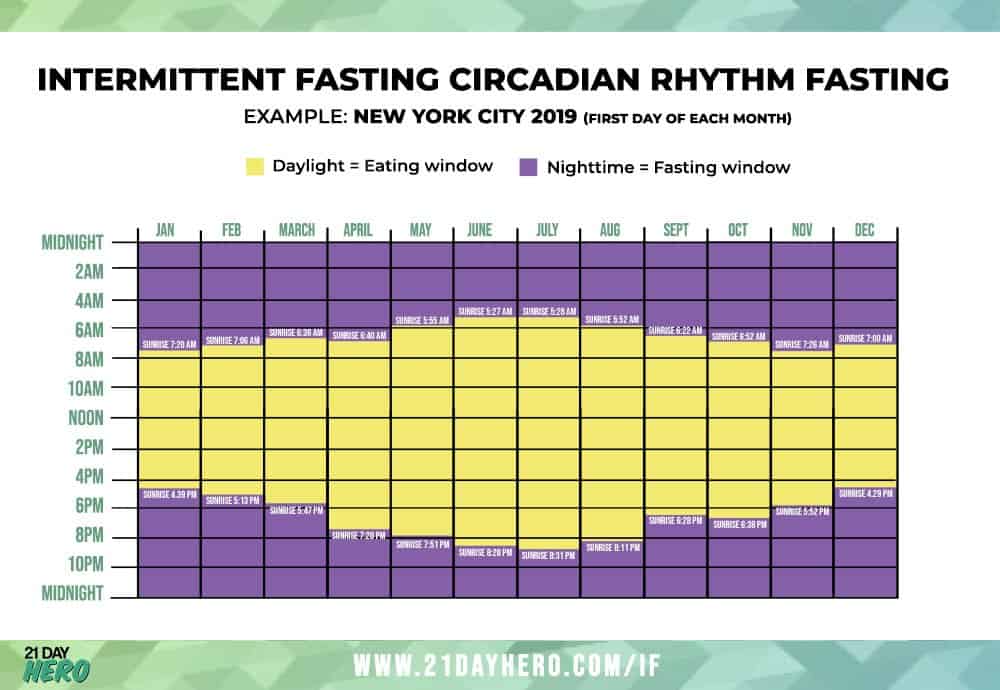
Extended A.K.A Prolonged Fasting
How: Fast for more than 24 hours once a month
As mentioned before, extended or prolonged fasting usually means anything between 24 and 96 hours of fasting.
It is not recommended to do it more often than once a month and anything above 48-72h of fasting should be done under a doctor's supervision.
Yes, there are lots of people who don't follow this recommendation and nothing happens, but it is risky and we do not recommend it if you are not experienced faster and especially if you have any of the medical conditions described above.
For more in-depth guide on prolonged fasting, read Prolonged Fasting 101: How To Do It & What Are The Benefits?.
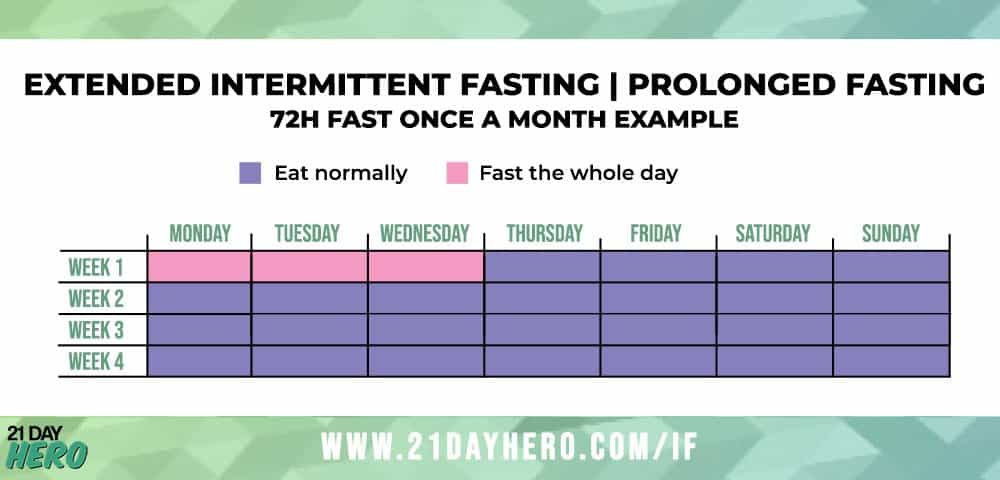
Recommended Intermittent Fasting Schedule for Beginners
Here at 21 Day Hero we always recommend starting with the most popular and beginner-friendly method – Intermittent Fasting 16/8.
For our 21-day Intermittent Fasting Challenge, we recommend easing into Intermittent Fasting by starting with 12h of fasting and 12h of eating and adding one fasting hour each day until you reach the desired 16/8 schedule.
See the image below with two examples of how your first week of 16/8 Intermittent Fasting and your Intermittent Fasting hours could look like.
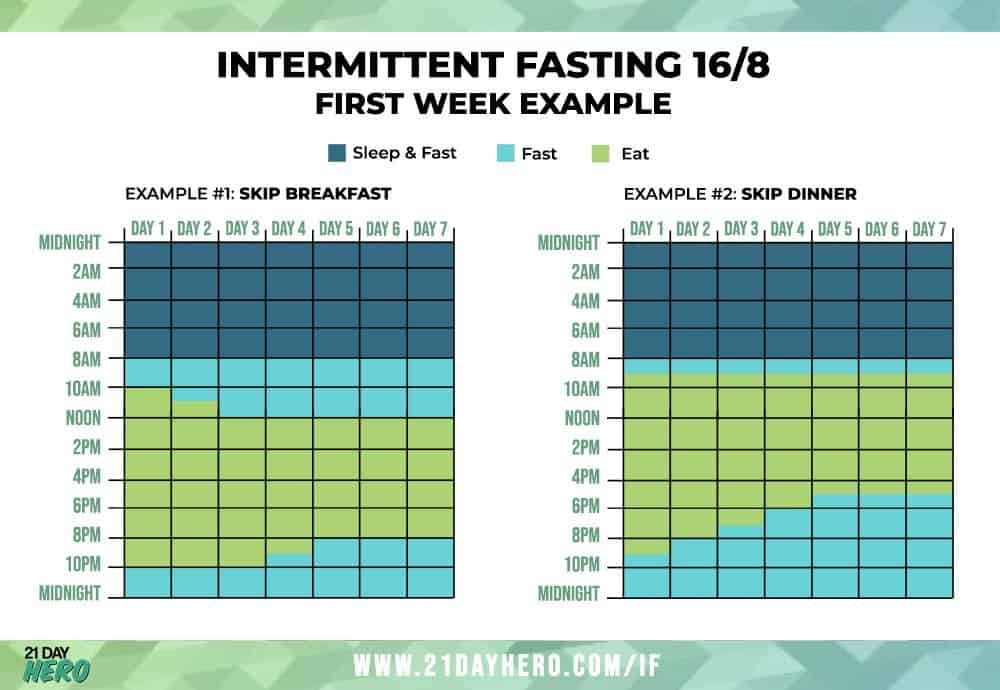
Note: 16/8 also happens to be the most popular method among celebrities. If you are curious to know how they practice fasting and what are the main benefits (Coldplay soloist Chris Martin even believes Intermittent Fasting helps him to sing better!), check out our blog post on How to do Intermittent Fasting According to 40 Famous People.
What to Eat During Intermittent Fasting
A popular misconception is that you can allow yourself to eat anything while doing Intermittent Fasting, including fast food, sugary and highly processed dishes. If your goal is to lose weight, improve productivity and simply get healthier, it is essential to stick to healthy meals.
This means eating whole foods and avoiding the usual suspects such as sugar, processed foods, empty carbs, etc.
The type of diet you choose is up to you; as long it is balanced and fits your lifestyle. For many, Keto Diet has proven to be a great supplement to Intermittent Fasting, as it may help you burn more fat.
If you are still not sure how to implement a new healthier diet to support your Intermittent Fasting goals and make your Intermittent Fasting journey easier?
Great news – together with a professional dietitian, we have prepared a balanced21-Day Intermittent Fasting meal plan (pdf).You can choose meal plans based on your gender, age, physical activity and diet (keto/low-carb, vegan, vegetarian, paleo and regular balanced diet options available).
See the Intermittent Fasting Meal Plans HERE
What to Drink During Intermittent Fasting
To get all the health benefits of Intermittent Fasting such as fat loss, increased metabolic rate, lower blood sugar levels, boost in the immune system and others, you have to restrict from consuming any caloric food. But you can still consume non-caloric beverages because they do not break your fast and allow you to get all the benefits of fasting.
This is because non-caloric beverages do not cause the release of insulin, and as a consequence, do not interfere with fat burning and autophagy (cellular cleanup).
This would include:
- Water
- Sparkling water
- Mineral water
- Plain black coffee
- Plain tea
Got more questions about Intermittent Fasting Drinks? We've got more information in our blog post What Can You Drink During Intermittent Fasting.
Best Intermittent Fasting Apps to Track Fasting
Sometimes technology can really be our best friend and help us stick to our commitments.
If you need extra support or simply want to make your life easier, there are a number of intermittent fasting apps available on the market to help you out.
We have reviewed several apps and made our list of the best intermittent fasting apps. Here's our top 2:
- DoFasting (Get it here)
- Life Fasting Tracker (Get it here)
You can find a comprehensive review of all 6 intermittent fasting apps here, to get more information on the pros and cons of each fasting app, costs, and other features.
Intermittent Fasting Plan: 21-day Daily Guide
To help you kick-off your Intermittent Fasting journey in an easy, fun and sustainable (!) way, we prepared a 21 Day Intermittent Fasting Plan that gives you an action for each day, with a detailed description and more learnings.
Scroll down and see a preview of the first 7 Intermittent Fasting days. If you feel like it's time to take matters in your own hands and make Intermittent Fasting a sustainable lifestyle, join our 21-day Intermittent Fasting Challenge. It gives you access to the full 21-day Intermittent Fasting plan, daily emails and further tips and tricks for Intermittent Fasting Beginners (and more experienced!).

Day 1
TODAY'S TASK: 12 h Fast | 12 h Eat
TODAY'S MISSION: Pick your Intermittent Fasting schedule
During the first week, you want to slowly ease into your intermittent fasting. This is why we suggest starting with 12 hours of fasting on your first day, and steady go up to 16 hours on Day 5, by adding 1 additional hour of fasting each day. That way it is easier for your body and brain to get used to the new way of eating, also you give yourself more time to get used to Intermittent Fasting.
On your first day, we also want you to choose the Intermittent Fasting schedule that fits your lifestyle best, and that you will stick to during the entire 21-day Intermittent Fasting Challenge. Consistency has proven to be one of the most contributing factors to success, see more in our talk with clinical researcher Megan J. Ramos.
Day 2
TODAY'S TASK: 13 h Fast | 11 h Eat
TODAY'S MISSION: Learn the basics of Intermittent Fasting
On Day 2, you will be extending your fast to 13 hours. Just one additional hour compared to yesterday – you can do it!
Day 2 is great to get you introduced into healthy eating guidelines that will support your Intermittent Fasting goals: simply focus on eating more whole foods and avoiding the usual suspects such as sugar, processed foods, empty carbs etc.
We will provide you a list of typical meals and foods you could eat to get better Intermittent Fasting results. Think simple though delicious and balanced meals you can do at home, such as poached eggs with spinach, meatballs with zucchini noodles, feta cheese salad or homemade hummus for a snack.
Day 3
TODAY'S TASK: 14 h Fast | 10 h Eat
TODAY'S MISSION: Define your rewards
Rewards are crucial when establishing your new Intermittent Fasting habit. Hence on Day 3 we want you to define your own rewards for each successfully fasted day.
Why are rewards so important?
A reward sends a positive signal to your brain, saying "Doing this feels good, we should do more of it!". It could be anything that makes you feel good.
Ideally, the best Intermittent Fasting reward should be related to your primal needs for relaxing, socializing, food or playing.
Or, your reward could also be a simple (but powerful!) celebratory action you do immediately after completing the habit like cheering yourself up and saying "Good job" or ticking yet another day off of your daily progress tracking sheet you receive when joining the challenge.
If the reward is bigger, for example, dinner at a pricey but so delicious restaurant, you can try token technique – e.g., each successful day fasting "gives you" 1 token. When you have collected 5 tokens, you get to treat yourself and go out to the restaurant.
Day 4
TODAY'S TASK: 15 h Fast | 9 h Eat
TODAY'S MISSION: Prepare a high protein lunch
On Day 4 of Intermittent Fasting, you will be fasting for 15 hours already! To break your fast, we recommend having a high protein lunch, which will support your weight loss goals.
For example, you can make yourself steamed or grilled veggies with a protein of your choice, such as grilled meat, poultry, fish, tofu, eggs, beans, legumes or nuts, and seeds.
If you are looking for inspiration, we recommend to check out this delicious summer grapefruit salad with wild salmon?
Day 5
TODAY'S TASK: 16 h Fast | 8 h Eat
TODAY'S MISSION: Drink black coffee when hungry
On Day 5 of Intermittent Fasting Plan, you will finally be reaching your ultimate 16/8 Intermittent Fasting schedule of fasting for 16 hours and eating within 8 hours window. And… it will actually be pretty easy to achieve, something we have seen ourselves and in hundreds of people that already took the 21 Day Intermittent Fasting challenge.
To help you go through the 16 hours of fasting and curb your hunger, in case you are experiencing one, we recommend drinking black coffee. It is full of antioxidants and is appetite suppressing, too (do not overdo it though!).
Keep in mind: Intermittent Fasting coffee is black coffee. Meaning, don't add any sugar, milk or creamers to it – no cappuccino, latte or flat white, only black coffee.
If you must have something sweet, add natural sweetener stevia, but be careful as it might instigate hunger.
Not a coffee drinker? Go for black or green tea or a glass of water.
Day 6
TODAY'S TASK: 16 h Fast | 8 h Eat
TODAY'S MISSION: Go for a walk
Are you hoping to lose some pounds during these 21 fasting days? It is important to stick to a healthy diet and we also recommend incorporating some exercise in your routine.
Go for a walk just before you break your fast. Even a quick 20 min walk will do the trick.
Walking is a great way to improve your overall fitness, your mood and simply get some fresh air. Most importantly, going for a walk will switch your focus from hunger and help you pass those last hours of fasting easier.
Day 7
TODAY'S TASK: 16 h Fast | 8 h Eat
TODAY'S MISSION: Go for a walk
Today, keep your new 16/8 Intermittent Fasting Schedule, and while doing so, reflect on your progress from the week.
Reflecting on your progress is part of success – to do so, take a full-body photo, record your weight and compare them with your starting weight and photo. You should start seeing the first results in your weight and/or physical appearance.
In addition, we want you to answer a couple of questions to reflect on your progress, such as how do you feel, if you have noticed changes in your energy, mood and skin from intermittent fasting, etc.
Going through an exercise like that will help you identify where, and most importantly, why you could be struggling and hence will help you to take actions to accelerate your results and make intermittent fasting a new sustainable habit.

Where to Learn More About Intermittent Fasting
Would you like to access the full 21-day Intermittent Fasting plan and get a detailed 16/8 Intermittent Fasting guide? Also, receive an Intermittent Fasting food list, learn more about Intermittent Fasting and have somebody help you to implement it to your life successfully?
Join our 21-Day Intermittent Fasting Challenge and get all the information you need in one place to successfully master the intermittent fasting lifestyle. And finally, lose that weight you've been dreaming of!
Wait no more and sign up to the 21-Day Intermittent Fasting Challenge here.
Is Intermittent Fasting Sustainable
Source: https://21dayhero.com/intermittent-fasting-daily-plan/

Leave a Comment